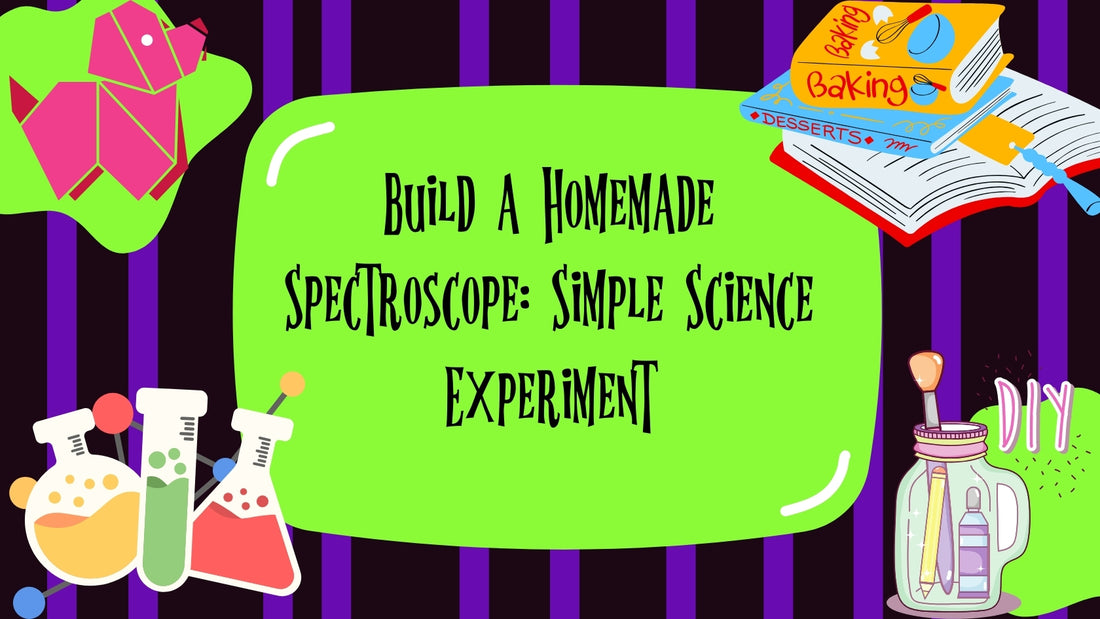As an affiliate, I earn from qualifying purchases, but this doesn't affect the reviews or recommendations—your trust is important to me!
Build a Homemade Spectroscope: Simple Science Experiment

Today, We're Making:
- - Homemade Spectroscope
- - 1. Exploring Light Spectrum: This experiment involves creating a homemade spectroscope using a cardboard tube, a DVD, and some black paper. After assembling the spectroscope, kids can use it to view different light sources like LEDs, sunlight.
Discover the Rainbow Secrets with a Homemade Spectroscope
Ever gazed at a rainbow and marveled at the wonder of color spectrum? Now, what if you could dissect light and peek into its rainbow-colored secrets right from the comfort of your home?
Well, with a homemade spectroscope, you can. If terms like light spectrum and prism science tickle your curiosity, then you're in for a delightful science experiment.
Build Your Personal Spectroscope
In this blog post, we’ll guide you through a simple science experiment to build your own homemade spectroscope.
Perfectly suited as an educational DIY opportunity, this engaging activity expertly combines science education with good old-fashioned home crafting, demystifying the realm of optical physics in a fun, easy-to-understand manner. So roll up those sleeves, and let the DIY Science begin!
Building a Homemade Spectroscope: A Fun DIY Science Project
Building a homemade spectroscope can seem like a daunting task, given its fancy name and sophisticated scientific aura. But hold your thoughts! This DIY science project is simpler than you imagine. All you need is a CD, a small cardboard tube, some black paper, and an attitude of curious exploration. This science experiment could turn out to be one of the most compelling science projects you've embarked on.
The Magic of the Homemade Spectroscope
The core essence behind a spectroscope is its ability to break light into its constituent wavelengths, allowing us to view the dazzling color spectrum. This is precisely what makes the homemade spectroscope such a delight for both kids and adults. It's not just another simple science experiment, but a captivating prism science display right at home. Imagine having your very own home laboratory, once the realm of experts, here in your living room!
As you assemble the homemade spectroscope, you dive into the realm of optical physics. The CD, often overlooked as yesterday's tech, magically transforms into a grating to diffract light. The cardboard tube morphs into the viewing device. And, what do we have here? Your homemade spectroscope, ready to reveal to you the mysteries of spectrum analysis.
Learning Science Through Play
It’s remarkable how science for kids, or anyone for that matter, is not merely confined to textbook lessons. With our detailed steps on spectroscope construction, science education flirtatiously coalesces with playful building activities. This is learning science in a whole new way, making it an educational DIY project with a difference.
Homemade Spectroscope: A Fun Pastime Activity
Call this physics experiment, DIY science endeavors, or a homemade science project, the homemade spectroscope can easily turn into your favorite pastime. It’s science fun at home, ideal for those rainy afternoons or study breaks. Whether you're a science enthusiast, a parent looking for some quality bonding time, or a science educator eager to ignite a spark in youngsters, this experiment at home has the power to transform every moment into an enlightening interaction with science.
Ready to Build Your Own Spectroscope?
So, are you ready to roll up your sleeves and turn your dwelling into a personal physics lab, exploring practical physics in the most fun way? It's time to conquer spectroscopy basics as we guide you through this easy science experiment. It truly is a delightful and yet educational journey where you build your own spectroscope, turning a seemingly vast concept into something tangible and relatable. Remember, homemade spectroscope is not just a DIY - it's a wonder, a discovery, and a sheer delight of observing the world in its colorful essence.

And there you have it; the mystery of light unravelled right at your kitchen table.
With a homemade spectroscope, you've embarked on an incredible journey, right from the assembly of simple household items to the final reveal of nature's hidden color spectrum. This isn't just a science experiment, it's a hands-on learning adventure making complex science concepts accessible and fun.
So next time you see a rainbow, give yourself a pat on the back because you've mastered the art and science of spectroscopy at home. Here's to more discoveries and learning as we continue to unveil exciting science experiments that you can undertake right within your own four walls.
Have fun exploring!
You May Also Like These:
Exploring Light Spectrum: DIY Spectroscope
Ingredients
- 1 Cardboard Tube (a paper towel roll works great)
- 1 Pair of Scissors
- 1 Piece of Aluminum Foil
- 1 CD (preferable an old one)
- 1 Piece of Cardstock Paper
- Tape
- A Bright Light Source (a lamp or the sun)
Instructions
- Prepare the Cardboard Tube: Cut a small, square window (about 1 inch square) on one side of the cardboard tube, about 1 inch from the end. This will act as the light entry point for your spectroscope.
- Cover the Window: Cut a piece of aluminum foil slightly larger than the window you just cut out. Poke a very small hole in the middle of the foil with the tip of your scissors. Tape this foil over the window. The hole will focus the light into a beam that enters your spectroscope.
- Insert the CD: On the opposite end of the tube from the aluminum foil window, cut a slit at a 60-degree angle. Insert the CD into this slit with the shiny side facing up into the interior of the tube.
- Create the Viewing Window: On the same end that you inserted the CD, cut a viewing window just above the CD. This window should be rectangular and large enough to clearly see the CD inside.
- Block Excess Light: Cut a piece from the cardstock paper large enough to cover and wrap around the end of the tube where the CD and viewing window are. Cut a small rectangle matching the viewing window. Tape this piece onto the tube, covering all but the viewing window. This helps block out extra light and concentrate the colors you'll be seeing.
- Conduct the Experiment: Point the aluminum foil hole towards a bright light source. Look through the viewing window, you should see a spectrum of light - like a rainbow - reflected off the CD.
- Record Your Observations: Discuss and note down what colors you can see. You could even try this with different light bulbs to see if there are changes in the light spectrum.
Enjoy your exploration of the light spectrum and remember, learning about science, technology, engineering, and math (STEM) is always fun!
STEM/Experiment: Homemade Lava Lamp
Ingredients:
- 1 clear, clean glass container
- Vegetable Oil or any clear oil
- Water
- Food coloring (any color of your choice)
- Fizzing tablets (like Alka-Seltzer)
Instructions:
- Fill the glass container about 3/4 full with the oil.
- Then, fill the rest of the container with water, leaving some space at the top. Observe how oil and water do not mix.
- Add a few drops of the food coloring. Notice how the food coloring only colors the water and not the oil.
- Break the fizzing tablet into a couple of pieces and drop them into the container. Watch how it creates a cool lava lamp effect as it reacts with the water, creating gas bubbles which rise through the oil.
- Enjoy your homemade lava lamp and observe the principles of liquid density and the creation of gas.
Note: Be sure to supervise your child during the activity, particularly during the step involving the fizzing tablets.
Spectroscope STEM Experiment
Objective: To understand how light is refracted when passed through a spectroscope. Ingredients:- A compact disc (CD)
- A cereal box
- Black paper
- Scissors
- Sticky tape
- A ruler
Instructions:
Step 1:Cut out two rectangular pieces from the cereal box approximately 25 cm long and 4 cm wide.
Step 2:On one piece, cut a 2 cm slit in the middle and align it with the center of the CD. This serves as our diffraction grating.
Step 3:On the black paper, cut out a rectangle that matches the size of the cereal box piece and stick it on top with tape.
Step 4:On the other cereal box piece, cut out a smaller rectangle, about 1 cm wide and 1/2 cm tall. This will be the eyepiece of your spectroscope.
Step 5:Place the cereal boxes with cuts on either end of the CD. Make sure the CD is oriented in such a way that it covers the slits on both ends. Secure them with tape.
Step 6:Your spectroscope is now ready! Look through the smaller peep hole aiming the other end towards a source of light. You should see the spectrum of the light.
Experiment: Exploring Different Light Sources with LEDs
Objective:
This activity aims to help children understand and compare different sources of light, particularly LEDs, and how their light production affects visibility and color perception.
Ingredients:
- White LED light
- Red LED light
- Blue LED light
- Yellow LED light
- Green LED light
- Different colored objects (beads, blocks or papers)
- A dark room
Instructions:
- Gather all materials: Collect all the LED lights and colored objects, and find a room that can be made completely dark.
- Organize the colored objects: Arrange the colored items in a specific order, so that color changes can be more easily observed.
- Turn off the lights: Ensure the room is completely dark before beginning the experiment.
- Start with one light: Turn on one LED light and shine it on each colored object. Ask the kids to discuss and note down how each object appears under this light.
- Switch lights: Next, repeat the process with each LED light. Remember to turn off each light before switching to the next, so you can observe the changes in color and visibility effectively.
- Compare and discuss: Once finished, compare notes on what differences were observed under different light sources. Discuss how different light sources can impact the way we perceive color.
Conclusion:
By the end of the experiment, kids should have an understanding of how light sources like LEDs can impact our perception of color. This activity also serves to introduce kids to various principles of physics and optics in a fun and engaging way.
STEM Experiment: Understanding Sunlight
Objective:
To demonstrate and understand how sunlight is responsible for creating shadows. The experiment also helps children learn about the movement of the sun across the sky by observing changing shadow lengths and directions.
Ingredients:
- A sunny day
- Flat outdoor space
- A long stick or a tall toy
- Chalk or markers
- A clock or watch
Instructions:
- Find a sunny spot outdoors where the sun will not be obstructed by trees or buildings throughout the day.
- Place the long stick or tall toy on the ground, making sure it stands upright. This will be our 'sun tracker'.
- Using chalk or a marker, draw a line around the base of the stick or toy.
- At regular intervals (suggest every hour), observe and mark at the end of the shadow cast by the 'sun tracker'. Make sure to note down the time next to each shadow mark.
- Repeat this process until the sun sets or as long as you can see the shadow of the 'sun tracker'.
- Observe how the shadow changes direction and length as time passes, and discuss why this happens.
Learning Outcome:
Through this experiment, kids will able to understand the concept that the earth rotates on its axis causing the position of the sun in the sky to change, which in turn changes the direction and length of the shadows. This is a fundamental concept in understanding time, seasons, and the larger universe around us.



























